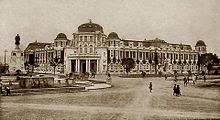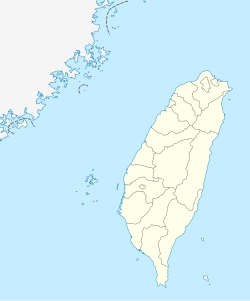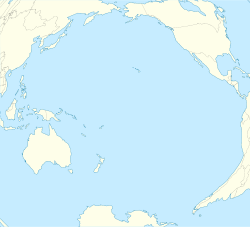
A | B | C | D | E | F | G | H | CH | I | J | K | L | M | N | O | P | Q | R | S | T | U | V | W | X | Y | Z | 0 | 1 | 2 | 3 | 4 | 5 | 6 | 7 | 8 | 9
Taipei City 臺北市[I] Tai-pak, Taipeh, Taihoku | |
|---|---|
Clockwise from top: Taipei 101 in the center of Taipei skyline, Presidential Office, Qixing Mountain, National Palace Museum, Bangka Lungshan Temple, Chiang Kai-shek Memorial Hall, Ximending | |
| Etymology: Wade–Giles: Tʻai²-pei³; lit. 'Taiwan north' | |
| Nickname(s): The City of Azaleas | |
 | |
 | |
| Country | |
| Settled | 1709 |
| Renamed to Taihoku | 17 April 1895 |
| Provinicial city status | 25 October 1945 |
| Provisional national capital | 7 December 1949 |
| Reconstituted as a Yuan-controlled municipality | 1 July 1967 |
| City seat | Xinyi District 25°02′15″N 121°33′45″E / 25.03750°N 121.56250°E |
| Districts | 12 |
| Largest district | Daan District |
| Government | |
• Mayor | Chiang Wan-an (KMT) |
| Legislature | Taipei City Council |
| National representation | |
| 8 of 113 constituencies | |
| Area | |
• Total | 271.80 km2 (104.94 sq mi) (16th) |
• Water | 2.7 km2 (1.0 sq mi) |
| Population | |
• March 2023 estimate | 2,494,813 (4th) 9,078,000 (urban)[1] (4th) |
| GDP (PPP) | 2016 estimate |
• Total | $65,539 (1st) |
| GDP (nominal) | 2016 estimate |
• Total | NT$990,292 (1st) |
| Time zone | UTC+8 (National Standard Time) |
| Calling code | (0)2 |
| Postal code | 100–116 |
| ISO 3166 code | TW-TPE |
| Website |
|
| Symbols | |
| Bird | Formosan blue magpie (Urocissa caerulea) |
| Flower | Azalea (Rhododendron nudiflorum) |
| Tree | Banyan (India laurel fig, Ficus microcarpa) |
| Taipei City | |||||||||||||||||||||||||||||||||||||||||||||||
|---|---|---|---|---|---|---|---|---|---|---|---|---|---|---|---|---|---|---|---|---|---|---|---|---|---|---|---|---|---|---|---|---|---|---|---|---|---|---|---|---|---|---|---|---|---|---|---|
 "Taipei" in Traditional (top) and Simplified (bottom) Chinese characters | |||||||||||||||||||||||||||||||||||||||||||||||
| Traditional Chinese | 臺北市 | ||||||||||||||||||||||||||||||||||||||||||||||
| Simplified Chinese | 台北市 | ||||||||||||||||||||||||||||||||||||||||||||||
| Literal meaning | "Tai North" | ||||||||||||||||||||||||||||||||||||||||||||||
| |||||||||||||||||||||||||||||||||||||||||||||||
Taipei (/ˌtaɪˈpeɪ/ ⓘ; Chinese: 臺北; pinyin: Táiběi),[4] officially Taipei City,[I] and previously known as Taihoku from 1895 to 1945, is the capital[a] and a special municipality of the Republic of China, commonly known as Taiwan.[7][8] Located in Northern Taiwan, Taipei City is an enclave of the municipality of New Taipei City that sits about 25 km (16 mi) southwest of the northern port city of Keelung. Most of the city rests on the Taipei Basin, an ancient lakebed. The basin is bounded by the relatively narrow valleys of the Keelung and Xindian rivers, which join to form the Tamsui River along the city's western border.[9]
The municipality of Taipei is home to an estimated population of 2,494,813 (March 2023),[10] forming the core part of the Taipei–Keelung metropolitan area, also known as "Greater Taipei", which includes the nearby cities of New Taipei and Keelung with a population of 7,047,559,[10][11] the 40th most-populous urban area in the world—roughly one-third of Taiwanese citizens live in the metro areas. The name "Taipei" can refer either to the whole metropolitan area or just the municipality alone. Taipei has been the political center of the island since 1887, when it first became the seat of Taiwan Province by the Qing dynasty until 1895 and again from 1945 to 1956 by the ROC government,[b] with an interregnum from 1895 to 1945 as the seat of the Government-General of Taiwan during the Japanese rule. The city has been the national seat of the ROC central government since 1949, it became the nation's special municipality (then known as Yuan-controlled municipality) on 1 July 1967 from provincial city status.
Taipei is the economic, political, educational and cultural center of Taiwan. It has been rated an "Alpha − City" by GaWC.[12] Taipei also forms a major part of a high-tech industrial area.[13] Railways, highways, airports and bus lines connect Taipei with all parts of the island. The city is served by two airports – Songshan and Taoyuan. The municipality is home to architectural and cultural landmarks, including Taipei 101 (which was formerly the tallest building in the world), Chiang Kai-shek Memorial Hall, Dalongdong Baoan Temple, Hsing Tian Kong, Lungshan Temple of Manka, National Palace Museum, Presidential Office Building, Taipei Guest House and Zhinan Temple. Shopping districts including Ximending as well as several night markets dispersed throughout the city. Natural features include Maokong, Yangmingshan and hot springs.
In English-language news reports, the name Taipei often serves as a synecdoche referring to the central government that controls the Taiwan Area. Due to the ambiguous political status of Taiwan internationally, the term Chinese Taipei is also frequently used as a synonym for the entire country, as when Taiwan's governmental representatives participate in international organizations or when Taiwan's athletes compete in international sporting events, including the Olympics.
Names
The spellings Taipei and Tʻai-pei derive from the Wade–Giles romanization Tʻai²-pei³[14] which means the North of Taiwan in Chinese. The name could be also romanized as Táiběi according to Hanyu Pinyin and Tongyong Pinyin.[15][16][17]
The city has also been known as Tai-pak[18][19] (derived from Taiwanese Hokkien) and Taipeh.[20][21]
During the Japanese rule, Taipei was known as Taihoku, which is the pronunciation of the Chinese characters (Kanji) for Taipei in Japanese.[failed verification][22]
History

Prior to the significant influx of Han Chinese colonists, the region of Taipei Basin was mainly inhabited by the plains aborigines called Ketagalan. The number of Han colonists gradually increased in the early 18th century under Qing Dynasty rule after the government began permitting development in the area.[23] In 1875, the northern part of the island was incorporated into the new Taipeh Prefecture.
It was formerly established as Taipeh-fu and was the temporary capital of the island in 1887 when it was declared a province (Fukien-Taiwan Province).[24][25] Taipeh was formally made the provincial capital in 1894. The romanized transcription of Taipeh was changed to Taihoku in 1895 when the Empire of Japan annexed Taiwan, based on the Japanese reading of the two characters. The writing in Chinese characters remained unaltered. Under Japanese rule, the city was administered under Taihoku Prefecture. Taiwan's Japanese rulers embarked on an extensive program of advanced urban planning that featured extensive railroad links. A number of Taipei landmarks and cultural institutions date from this period.[26]
Following the surrender of Japan to the Allies during 1945, effective control of Taiwan was handed to the Republic of China (ROC). After facing defeat from Communist forces, the ruling Kuomintang relocated the ROC government to Taiwan and declared Taipei the provisional capital of the ROC in December 1949.[27][28][29] Taiwan's Kuomintang rulers regarded the city as the capital of Taiwan Province and their control as mandated by General Order No. 1.
In 1990, Taipei provided the backdrop for the Wild Lily student rallies that moved Taiwanese society from one-party rule to multi-party democracy by 1996. The city has ever since served as the seat of Taiwan's democratically elected national government.
Early settlers–Qing dynasty
The region known as the Taipei Basin was home to Ketagalan tribes before the eighteenth century.[30] Han Chinese colonists from Dabu County, Yongding County, Anxi and Tong'an of Southern Fujian began to settle in the Taipei Basin in 1709.[31][32]
In the late 19th century, the Taipei area, where the major Han Chinese settlements in northern Taiwan and one of the designated overseas trade ports, Tamsui, were located, gained economic importance due to the booming overseas trade, especially that of tea export. In 1875, the northern part of Taiwan was separated from Taiwan Prefecture and incorporated into the new Taipeh Prefecture as a new administrative entity of the Qing dynasty.[26] Having been established adjoining the flourishing townships of Bangka, Dalongdong, and Twatutia, the new prefectural capital was known as Chengnei (Chinese: 城內; pinyin: chéngnèi; Pe̍h-ōe-jī: siâⁿ-lāi), "the inner city", and government buildings were erected there. From 1875 until the beginning of Japanese rule in 1895, Taipei was part of Tamsui County of Taipeh Prefecture and the prefectural capital.[33]
In 1885, as work commenced to govern the island as a province, Taipeh was thus temporarily designated as a provincial capital. The city officially became the capital in 1894.[citation needed] Nowadays, all that remains from the historical period is the north gate. The west gate and city walls were demolished by the Japanese while the south gate, little south gate, and east gate were extensively modified by the Kuomintang and have lost much of their original character.[34]
Empire of Japan


As settlement for losing the First Sino-Japanese War, China ceded the island of Taiwan to the Empire of Japan in 1895 as part of the Treaty of Shimonoseki. After the Japanese takeover, Taipei, romanized into English as Taihoku following the Japanese language pronunciation, was retained as the capital. It subsequently emerged as the political center of the Japanese Colonial Government.[26] During that time the city acquired the characteristics of an administrative center, including many new public buildings and housing for civil servants. Much of the architecture of Taipei dates from the period of Japanese rule, including the Presidential Office Building which was the Office of the Governor-General of Taiwan.
During Japanese rule, Taihoku was incorporated in 1920 as part of Taihoku Prefecture. It included Bangka, Twatutia, and Jōnai (城內) among other small settlements. The eastern village of Matsuyama (松山庄, modern-day Songshan District, Taipei) was annexed into Taihoku City in 1938. Taihoku and surrounding areas were bombed by Allied forces on several occasions. The largest of these Allied air raids, the Taihoku Air Raid, took place on 31 May 1945.
Post-WW2 under ROC



Upon the Japanese defeat following the nuclear bomb destruction of Hiroshima and its consequent surrender in August 1945, the Kuomintang (Chinese Nationalist Party) assumed control of Taiwan. Subsequently, Taipei was established as a provincial city and a temporary Office of the Taiwan Province Administrative Governor was established in it.[35] In 1947 the Kuomintang (KMT) government under Chiang Kai-shek declared island-wide martial law in Taiwan as a result of the 28 February Incident, which began with incidents in Taipei but led to an island-wide crackdown on the local population by forces loyal to Chiang. Two years later, on 7 December 1949, Chiang and the Kuomintang forces were forced to flee mainland China by the after defeat by Communist revolutionaries. The KMT-led national government that fled to Taiwan declared Taipei to be the provisional capital of a continuing Republic of China.[27][28]
Taipei expanded greatly in the decades after 1949, and as approved on 30 December 1966, by the Executive Yuan, Taipei was declared a special municipality on 1 July 1967.[32] In the following year, Taipei City expanded again by annexing Shilin, Beitou, Neihu, Nangang, Jingmei, and Muzha. At that time, the city's total area increased fourfold by absorbing several outlying towns and villages and the population increased to 1.56 million people.[32]
The city's population, which had reached one million in the early 1960s, also expanded rapidly after 1967, exceeding two million by the mid-1970s. Although growth within the city itself gradually slowed thereafter[35] — its population had become relatively stable by the mid-1990s – Taipei remained one of the world's most densely populated urban areas, and the population continued to increase in the region surrounding the city, notably along the corridor between Taipei and Keelung.[original research?]
In 1990, Taipei's 16 districts were consolidated into the current 12 districts.[36] Mass democracy rallies that year in the plaza around Chiang Kai-shek Memorial Hall led to an island-wide transition to multi-party democracy, where legislators are chosen via regularly scheduled popular elections, during the presidency of Lee Teng-Hui.[original research?]
Geography


Taipei City is located in the Taipei Basin in northern Taiwan.[37] It is bordered by the Xindian River on the south and the Tamsui River on the west. The generally low-lying terrain of the central areas on the western side of the municipality slopes upward to the south and east and especially to the north,[9] where it reaches the 1,120 m (3,670 ft)-tall Qixing Mountain, the highest (dormant) volcano in Taiwan in Yangmingshan National Park. The northern districts of Shilin and Beitou extend north of the Keelung River and are bordered by Yangmingshan National Park. The Taipei city limits cover an area of 271.7997 km2 (104.9425 sq mi),[38] ranking sixteenth of twenty-five among all counties and cities in Taiwan.
Two peaks, Qixing Mountain and Mt. Datun, rise to the northeast of the city.[39] Qixing Mountain is located on the Tatun Volcanic Group; its 1,120 m (3,670 ft)-high main peak renders it the tallest mountain at the rim of the Taipei Basin; 1,092 m (3,583 ft)-high Mt. Datun is a close runner up. These former volcanoes make up the western section of Yangmingshan National Park, extending from Mt. Datun northward to Mt. Caigongkeng (菜公坑山). Located on a broad saddle between two mountains, the area also contains the marshy Datun Pond.
To the southeast of the city lie the Songshan Hills and the Qingshui Ravine, which form a barrier of lush woods.[39]
Climate
| Taipei | ||||||||||||||||||||||||||||||||||||||||||||||||||||||||||||
|---|---|---|---|---|---|---|---|---|---|---|---|---|---|---|---|---|---|---|---|---|---|---|---|---|---|---|---|---|---|---|---|---|---|---|---|---|---|---|---|---|---|---|---|---|---|---|---|---|---|---|---|---|---|---|---|---|---|---|---|---|
| Climate chart (explanation) | ||||||||||||||||||||||||||||||||||||||||||||||||||||||||||||
| ||||||||||||||||||||||||||||||||||||||||||||||||||||||||||||
| ||||||||||||||||||||||||||||||||||||||||||||||||||||||||||||
Taipei has a humid subtropical climate (Köppen: Cfa).[40][41][42][43] Summers are long-lasting, very hot and humid, and accompanied by occasional heavy rainstorms and typhoons; while winters are short, generally warm and generally very foggy due to the northeasterly winds from the vast Siberian High being intensified by the pooling of this cooler air in the Taipei Basin. As in the rest of Northern Taiwan, daytime temperatures of Taipei can often peak above 26 °C (79 °F) during a warm winter day, while they can dip below that same level during afternoon showers and thunderstorms in the summer. Occasional cold fronts during the winter months can drop the daily temperature by 3 to 5 °C (5.4 to 9.0 °F), though temperatures rarely drop below 10 °C (50 °F).[44] Extreme temperatures ranged from −0.2 °C (31.6 °F) on 13 February 1901 to 39.7 °C (103.5 °F) on 24 July 2020, while snow has never been recorded in the city besides on mountains located within the city limit such as Yangmingshan. Due to Taiwan's location in the Pacific Ocean, it is affected by the Pacific typhoon season, which occurs between June and October.













